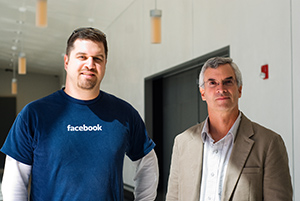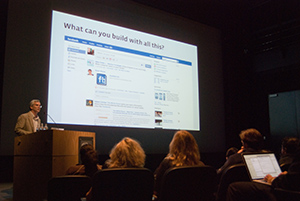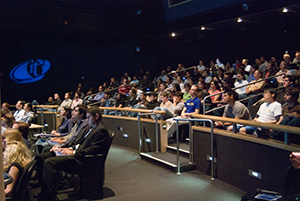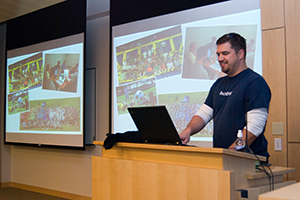|
Campus Visit by Facebook Grabs Students’ Attention, Sparks Career Aspirations
Roxana Popescu | Oct. 12, 2009

Taner Halicioglu '96 (left) and Jeff Rothschild.
When Facebook has something to say, social media experts, the tech and business worlds, aspiring software engineers – not to mention its 300 million users – tune in. When that message is, “We’re hiring,” they line up. With resumes, questions and oodles of hope.
The social networking monolith was on campus Thursday promoting its company, lecturing about its technology and inviting students to apply for jobs.
While it's typical for firms to give recruiting presentations to UCSD students and graduate students, this is the first time Facebook has done so on campus. Facebook representatives also participated in a series of technical meetings with UCSD faculty and students, hosted by Amin Vahdat, a professor of computer science and engineering and director of the Center for Networked Systems at the Jacobs School of Engineering.
At a morning lecture in the Calit2 auditorium, Jeff Rothschild, Facebook's vice president of technology, spoke about scaling, or how a growing company addresses technological and organizational challenges.
Today, Facebook boasts 200 billion monthly page views, between 2 and 3 billion new photo uploads every month, more than a quarter million requests per second on its servers, and 25 terabytes of data per day in traffic on its internal Scribe system – as of last count – Rothschild said.

Jeff Rothschild addressed some of the technological and organizational challenges Facebook is dealing with as it expands.
Storing, organizing, and then retrieving heaping mountains of data in instants is a constant conundrum, he said.
For example, on most Web sites, a user logs on to retrieve or modify his or her own information – think of Pandora.com, an online bank account interface, or a personal homepage. But on Facebook, users want to read and react to other people’s profiles, sometimes multiple times per minute.
To the user, tagging a friend in a friend photo is as easy as 1-2-3. But behind the scenes, Rothschild said, the data undergoes a complicated series of movements to get from server to screen. The more people are tagging, the more inventive engineers need to get with both software and hardware.
Also, in the old days, Facebook was strictly a college site, allowing profiles and other account components to be stored based on those associations – people from Harvard looking up their classmates, that is. Facebook got its start in a Harvard dorm room. Today, people come from a variety of age groups, backgrounds, contexts and affiliations, with Superbowl followers connecting with Thai food lovers and Ryan Seacrest fans across the world.
“There really is no good way of grouping this data,” he said.

Audience members learned about Facebook's technologies and employment prospects.
The solution: a super-fast cache, or method for storing and retrieving data, which he calls “the heart of the system.”
Amid the highly specialized infobytes about load balancing, server organization, and how new tools get developed, Rothschild offered several gems that any aspiring entrepreneur or social media enthusiast could relate to.
“Work fast and don’t be afraid to break things,” is the mantra at Facebook, he said. “If you take down the site, it’s not going to be the end of your career.”
Making mistakes, he concluded, is better than not striving in the first place.
At the end of his talk, Rothschild made his employment pitch. A slide popped up titled “Areas for future research – want to help?”
“Our door is open,” he stated.
It seems students heeded the invitation: hours later, at the afternoon session, a Facebook recruiter was already parsing resumes brought in by students.
The afternoon speaker hit closer to home. Taner Halicioglu graduated from UCSD (Revelle College, 1996, he informed the crowd) before he joined Facebook as the company’s first outside hire, way back in 2004. He recalled how he “pretty much lived in the data center” in his first months with the company and summarized some of the company’s core principals with playful alliterations.

Halicioglu joined Facebook as the company’s first outside hire in 2004.
“Simplicity is sublime.”
“Abstraction is awesome.”
“Data is delicious.”
Students ate it up.
Cliff Li, an electrical engineering graduate student, said Facebook is “a place I’ve dreamed of” working and is considering applying there when he graduates.
Roy Tang, a graduate student in the department of computer science and engineering, drew a parallel between Facebook and Google – both are growing in leaps and bounds and aiming to make advances in markets outside the United States, he said. Tang sees huge potential for Facebook to spread around the world, and he’d love to be the man to help bring it to new markets.
The students said a job with Facebook would be attractive any time, but particularly in this economic climate.
As long as the site keeps growing, they just might have a chance. After all, 300 million users means there’s potential for more than 6 billion more to sign up – and keep things interesting for Facebook’s engineers.

|